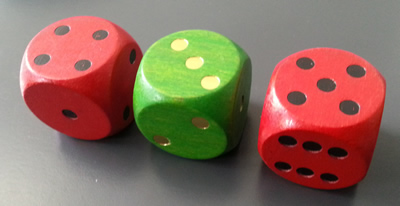Copyright © University of Cambridge. All rights reserved.
'Roll These Dice' printed from https://nrich.maths.org/
Show menu
Why do this problem?
This activity offers practice in addition and subtraction, including negative results, but the main aim is for pupils to concentrate on making sure that all the ways of rolling the three dice are reached. This will need some sort of system and you could focus on how answers could be recorded.
Possible approach
You could introduce the problem using real dice and modelling the calculation a few times so that pupils get a feel for it. Once a few results have been recorded on the board, invite the pupils to speculate on how many different results there might be.
Ask them to work in pairs or small groups on the problem, saying very little else at this stage, but after a short time, bring them together again to share insights so far. Discuss the range of answers that learners have found up to that point and make sure they are happy with subtracting one number from a smaller number. (Using a number line which includes negative numbers might be helpful at this point.) Invite some pairs to describe how they are working. Some may be throwing real dice, others may be listing numbers. Encourage some sort of system so that they can be sure no results are left out. You could ask children to suggest ways of recording which would help - this could be in the form of a table or chart, but allow pupils to choose a way that suits them.
Key questions
What are all the different possible numbers?
What are the final answers by doing the addition and subtraction each time?
Is there a good way of making sure you find all the possibilities?
How will you record what you've found out?
Possible extension
For more extension work
Pupils can be challenged to use multiplication as well as addition and subtraction. After some experimentation, they could try to predict totals that will NOT be possible and explain their predictions.
Possible support
Most children will need dice to begin this activity. Some pupils will benefit from an adult working alongside them and asking questions along each step of the way until their confidence has increased.
